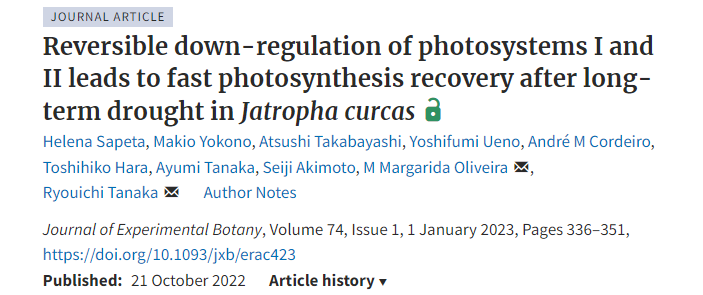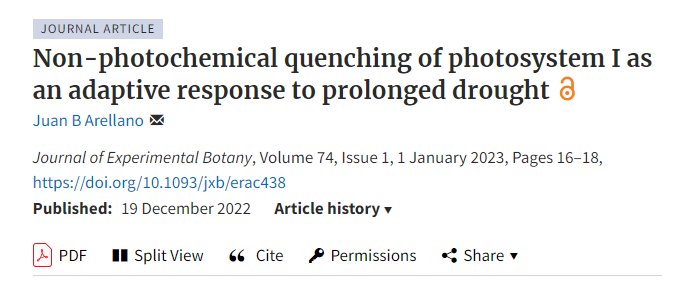Non-photochemical quenching of photosystem I protects photosynthetic machinery during drought stress in J. curcas
Jatropha curcas is a semi-evergreen plant, with a recognized high tolerance to drought. In the most recent study published in the Journal of Experimental Biology, Helena Sapeta and a team of researchers from ITQB UNL, and various institutions from Japan, offer a novel insight into the molecular machinery that allows this plant to survive weeks of water withdrawal. The partnership with Japan involved scientists from the Institute of Low Temperature Science of Hokkaido University and the Graduate School of Science of Kobe University.
The team analyzed the pigment and protein composition of photosystem I (PSI) and photosystem II (PSII) - large complexes responsible for absorbing and transferring light energy. Furthermore, they also looked into the thermal dissipation mechanisms of excess excitation energy absorbed by the light-harvesting complex (LHC) antennae of PSI and PSII. The researchers found indications that non-photochemical quenching (NPQ) takes place in PSI-LHCI decreasing PSI excitation and protecting J. curcas from uncontrolled photodamage under prolonged drought conditions. NPQ is a photoprotection mechanism of plants, which helps avoid photodamage via the dissipation of the excess absorbed energy as heat, and is usually associated with PSII.
The study revealed that, in J. curcas, PSI-LHCI accumulates large amounts of zeaxanthin under drought. It also showed that a large amount of zeaxanthin was still present during dark conditions. Zeaxanthin is a carotenoid that plants accumulate under excess light conditions as it increases photoprotection, and is associated with the development of NPQ. These findings suggest that sustained thermal dissipation also occurred in J. curcas, together with flexible NPQ in PSII-LHCII. Thus, Helena and the team concluded that this photoprotection of PSI-LHCI by NPQ, together with the NPQ of PSII-LHCII and the prompt PSII core complex recovery, permitted J. curcas to resume leaf CO2 assimilation and growth shortly after soil re-watering.
The NPQ of PSI-LHCI in J. curcas under drought stress brings into question whether this is a more general photoprotection mechanism found in evergreen species exposed to prolonged stress conditions.
This work was highlighted as an Insight Article in the Journal of Experimental Botany.
ORIGINAL PAPER
Helena Sapeta, Makio Yokono, Atsushi Takabayashi, Yoshifumi Ueno, André M Cordeiro, Toshihiko Hara, Ayumi Tanaka, Seiji Akimoto, M Margarida Oliveira, Ryouichi Tanaka, (2023) Reversible down-regulation of photosystems I and II leads to fast photosynthesis recovery after long-term drought in Jatropha curcas, Journal of Experimental Botany. DOI:10.1093/jxb/erac423




